v1.0.48 Laubwerk Plants Kit 5 – Temperate Coniferous Trees
EDIT in Admin Edit in WP
Downloads
Download demos and trial versions, product documentation, free presets and more.
You may download a free Demo after logging in.
Temperate Coniferous Trees
An impressive collection of temperate coniferous tree species planted in parks, gardens, or forests including excellent specimen trees for lawns such as eastern white pine, Japanese larch with good autumn color, and popular ornamental and live Christmas trees.
10 conifer tree species in 3 variants, 3 ages and 4 seasons each, for architects and CG artists working in 3ds Max, Maya, Cinema 4D and Trimble SketchUp.
3D Plants for CG Artists
Laubwerk offers easy-to-use software extensions for architects and CG artists looking for authentic 3D plants, and plant scattering tools.
With drag-and-drop simplicity, and easy-to-use tools that modify the shape, age, season and level of detail for each of Laubwerk’s stunning 3D plants, users can seamlessly add 3D trees to any CG project. For Autodesk 3ds Max & Maya, MAXON Cinema 4D, Trimble SketchUp, and Python.
Includes 360 Models
All Laubwerk Plants in this Kit come in 36 variations per species, i.e. 3 variants, 3 ages and 4 seasonal aspects. Here are a few examples of the variety:
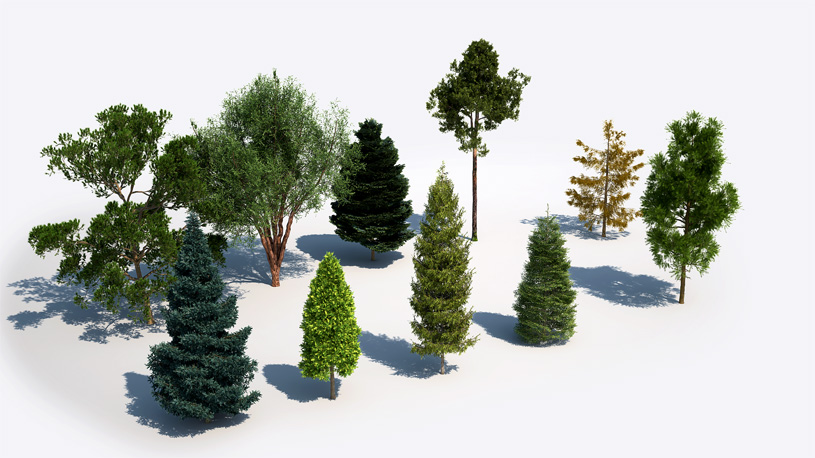
10 out of 360 temperate coniferous tree models of Laubwerk Plants Kit 5.
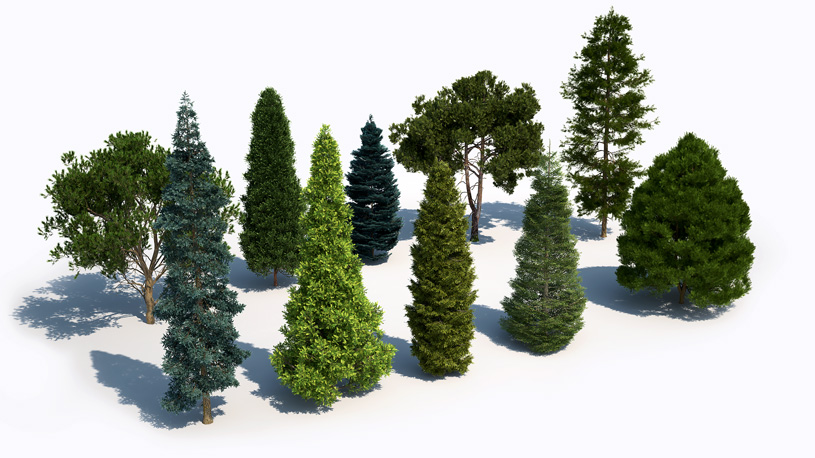
10 out of 360 temperate coniferous tree models of Laubwerk Plants Kit 5.
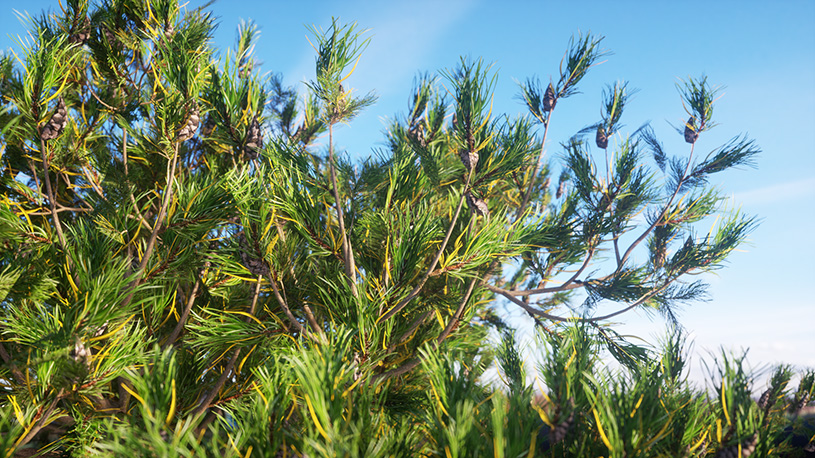
Includes Free Laubwerk Player
The free Laubwerk Player plugin comes bundled with each of the Laubwerk Plants Kits.
Use the Laubwerk Player to easily load and control plant models inside Autodesk 3ds Max & Maya, MAXON Cinema 4D and Trimble SketchUp. Just drag-and-drop your 3D tree, set the shape, age, and season and level of detail control. Watch the lightning fast rendering with inbuilt and 3rd parts renderer support.
Laubwerk Player Plugin
Inserting, controlling and rendering great-looking 3D tree models has never been easier with the Laubwerk Player plugin! The Laubwerk Player provides immediate visual access to your Laubwerk plant library. You get multiple drawing options in the viewport (like simple hull shape or skeleton) for quick feedback and low memory usage while editing your scene. And when you’re satisfied, watch the Laubwerk Player dynamically render fully-detailed plant models at amazing speeds, with automatic default materials and level of detail.
Plant Library Browser
The Plant Library Browser appears right in the 3ds Max, Maya, Cinema 4D or SketchUp main menu and provides direct access to the Laubwerk Plants installed on your computer. Drag-and-drop your 3D tree species into your scene or replace existing trees. Loading the plants through the Plant Library Browser directly creates materials with basic shading and textures preassigned, saving you time and memory while you work.
Plant Object
The Plant Object represents a Laubwerk plant model in your scene by using low-memory hull or skeleton mode for easy placement. It dynamically loads the model’s age and shape that you chose, creating a simple viewport approximation that allows you to apply model alterations and adjust level of detail settings. Laubwerk Plant Objects are fully scriptable using MaxScript.
V-Ray Support
Dedicated support of V-Ray saves you time and memory. Instead of manually converting Laubwerk Plant Objects into V-Ray proxies, the Plant Object detects when V-Ray is used for rendering and dynamically creates the model’s geometry during rendering. This is the exact same process V-Ray uses for V-Ray proxies, just automatically applied without any manual setup.
Renderer Support
Materials and textures are created on the fly – for the built-in renderer or third-party renderers.
- For 3ds Max, Maya, and Cinema 4D: mental ray, iray, Maxwell Render, Thea Render, Arnold, OctaneRender, Corona Renderer and Redshift.
- For SketchUp: V-Ray for SketchUp and Thea Render for SketchUp.
Laubwerk Advantage
- Plug and Play – One-click solution for architects and CG artists who need realistic 3D trees, immediately.
- Fast and Fluent – Render-ready 3D trees minimize the need for finetuning that can otherwise interrupt your workflow.
- Easy and Integrated – Drag-and-drop plants inside 3ds Max & Maya, and MAXON Cinema 4D, or Trimble SketchUp.
- Intuitive – Simple settings are a mouse click away.
- Smart Content – Go beyond static models! Choose the shape, age, season and detail of each tree.
- High Tech – Laubwerk technology minimizes the usual compromise between high-quality graphics and efficient memory usage.
Realistic 3D Tree Models
Laubwerk uses a hybrid of procedural modeling and hand-detailing by botanist and 3D artists to make the most realistic CG trees.
- Render-ready materials and textures are created on the fly – for the built-in renderer (3ds Max, Maya & Cinema 4D), or third-party renderers such as V-Ray, mental ray, iray, Maxwell Render, Thea Render, Arnold, OctaneRender, and Corona Renderer.
- Leaves consist of more than just a single polygon, so they bend and catch highlights.
- Textures are based on high quality photos from real trees.
- Models maintain shape and density, regardless of detail level.
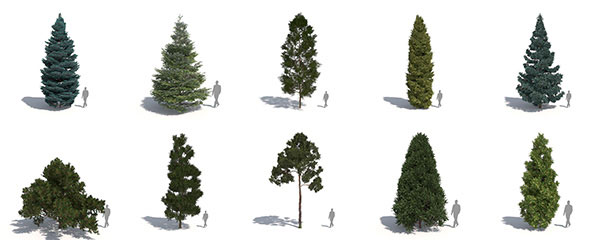
Plants Kit 5 includes 10 Laubwerk Plants:
- Colorado white fir (Abies concolor)
- Korean fir (Abies koreana)
- Japanese larch (Larix kaempferi)
- Norway spruce (Picea abies)
- Colorado blue spruce ‘Glauca’ (Picea pungens ‘Glauca’)
- shore pine (Pinus contorta subsp. contorta)
- eastern white pine (Pinus strobes)
- Scots Pine (Pinus sylvestris)
- common yew (Taxus baccata)
- western redcedar ‘Atrovirens’ (Thuja plicata ‘Atrovirens’)
Description
The following 10 tree species are included in the Plants Kit 5. Each species comes in 36 variations per species, i.e. 3 variants, 3 ages and 4 seasonal aspects, for a total of 360 models per Kit.
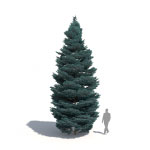 COLORADO WHITE FIR
COLORADO WHITE FIR
Abies concolor
Impressive medium to large evergreen coniferous tree. Crown initially very symmetrically conical, later more loose and rounded. Numerous spreading branches symmetrically arranged in layers on a ramrod straight trunk. Gray-white bark on mature stems with a smooth texture. Long, soft, intense bluish to grey-green needle-like leaves arching upward, shoots silvery grey, light yellowish grey in winter. Green or purple cones ripening pale brown. Native to the Rocky Mountains. Popular ornamental landscaping tree, Christmas tree, and Christmas decoration.
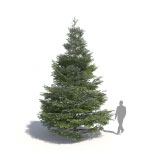 Korean Fir
Korean FirAbies koreana
Small to medium-sized evergreen coniferous tree with a symmetrical, conical crown and branches in layers. Grey-brown, smooth bark with resin blisters. Attractive foliage; short, wide, upward-curved needle-like leaves are glossy dark green, and densely packed and arranged around the twig like bristles of a brush. Numerous, showy upright cones, dark purple-blue before maturity, even on young trees. Native to the temperate rain forests of the higher mountains of South Korea. Popular ornamental plant in gardens in cool climates.
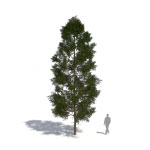 JAPANESE LARCH
JAPANESE LARCH
Larix kaempferi
Medium-sized to large deciduous coniferous tree with broad conical crown and horizontal branches. Gray bark with rusty-brown inner bark. Soft needle-like leaves appear in brush-like clusters, first light glaucous green, later pale green, turning bright golden yellow in autumn before falling in winter. Small, ovoid-conic, green cones are erect turning brown when mature and commonly persist on the branches. Forestry tree in Japan and Europe. Popular ornamental tree in parks and gardens with good fall color.
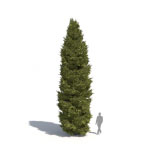 NORWAY SPRUCE
NORWAY SPRUCE
Picea abies
Large, fast-growing evergreen, conical coniferous tree. Primary branches are slightly upturned but secondary branches become pendulous as the tree matures. Red brown to grey brown bark. Needle-like, dark green foliage. Long green or reddish cones maturing brown. One of the most economically important conifers in Europe. Popular ornamental and Christmas tree.
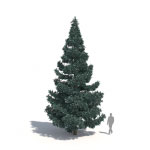 COLORADO BLUE SPRUCE ‘GLAUCA’
COLORADO BLUE SPRUCE ‘GLAUCA’
Picea pungens ‘Glauca’
Medium-sized to large coniferous evergreen tree with a conic, typically very narrow columnar crown. The dark green foliage grows in dense sprays. The seed cones are ovoid or oblong, green at first, maturing brown about 2 years after pollination. The dark green “exclamation mark” tree shape is considered as characteristic signature of Mediterranean landscapes. Trees are very long-lived.
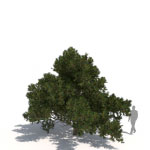 SHORE PINE
SHORE PINE
Pinus contorta subsp. contorta
Medium-sized evergreen pine tree with a somewhat sprawling and irregular, broadly rounded crown. Branches spreading, often contorted. Orange-brown to purple-brown bark irregularly furrowed and scaly. Medium to dark green needle-like leaves, which grow in pairs are short, coarse, and twisted. Small, orange-brown cones. Widely utilized in the landscape for its tough stature and adaptability. Planted in both in sandy areas subjected to salt spray or in ornamental gardens.
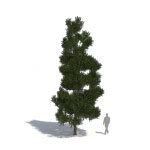 EASTERN WHITE PINE
EASTERN WHITE PINE
Pinus strobus
Large evergreen coniferous tree, pyramidal in its early years, then matures to a broad oval habit with an irregular crown. Smooth bark, flat lengthways fissures when old. Soft, bluish green needle-like leaves appear in bundles of five, like paint brushes at the ends of twigs. Long, slender, cylindrical, light brown cones. Important timber tree, popular as live Christmas trees, excellent specimen tree for lawns or parks.
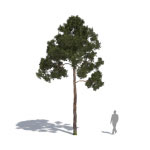 SCOTS PINE
SCOTS PINE
Pinus sylvestris
Medium-sized evergreen coniferous tree with a varying habit, conical to columnar crown when young. Then gradually with more extended branches on a long, bare trunk topped by a rounded or flat-topped crown. Thick, scaly dark grey-brown bark on the lower trunk and thin, flaky, and orange on the upper trunk and branches. Twisted blue-green needle-like leaves, which grow in pairs, more yellowish grey in winter. Small, grey-brown cones. Most widely distributed pine in the world. Important tree in forestry, popular ornamental and Christmas tree.
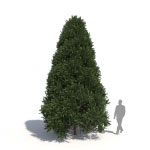 COMMON YEW
COMMON YEW
Taxus baccata
Small- to medium-sized evergreen coniferous tree with a broadly conical or ovoid, later domed or round crown. Thin, scaly reddish-brown bark, coming off in small flakes aligned with the stem. Lustrous, two-ranked, dark green needle-like foliage. Young shoots emerge light green. Red, ornamentally-attractive, berry-like fruits. Popular ornamental and landscaping tree.
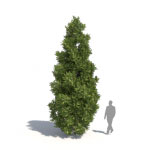 WESTERN REDCEDAR ‘ATROVIRENS’
WESTERN REDCEDAR ‘ATROVIRENS’
Thuja plicata ‘Atrovirens’
Medium-sized evergreen coniferous tree in the cypress family, which grows in a symmetrical, narrow conical shape. Fast growing tree with reddish, shredding bark. The dark-green foliage forms flat sprays with scale-like leaves in opposite pairs, shiny on the leaf top, and are strongly aromatic. Small, slender, upright cones are green to yellow-green, ripening brown in autumn. Popular ornamental and landscaping tree.
System Requirements
Computer Hardware | A computer that is capable of running your version(s) of 3ds Max, Maya, Cinema 4D, SketchUp. |
|---|---|
Hard Disk Space | 10MB of hard disk space and additional space for the Laubwerk Plants models. |
Supported Hosts |
|
Installation Instructions | Our aim is to make the installation process as easy as possible for you. If you like to get more information, we have compiled these Laubwerk Plants Kits installation instructions, including advanced topics such as considerations when working in a network. |
Change Log
Update 1.0.49 (April 5, 2024)
Update 1.0.48 (December 22, 2023)
Update 1.0.47 (November 15, 2023)
Update 1.0.46 (July 17, 2023)
Update 1.0.45 (June 19, 2023)Maya
3ds Max
Cinema 4D
|
FAQs
Tutorials

A Guide to Realistic Digital Vegetation Creation for 3D Landscapes
Creating immersive, realistic vegetation is an art form in itself. Learn about tools and libraries to help you create realistic vegetation.
More...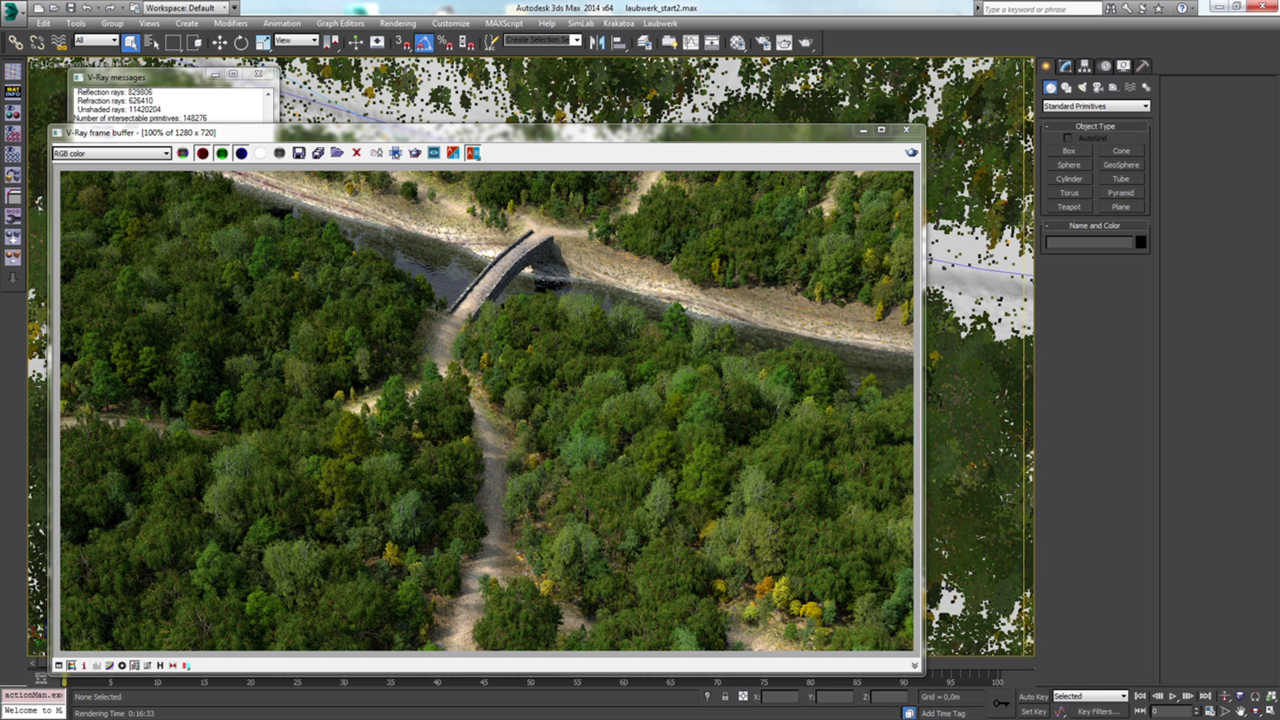
Laubwerk Plants integration with iToo Forest Pack
Learn how to use Forest Pack to instantly create stunning CG forest scenes using Laubwerk's line of beautiful, render-ready 3D tree species, inside Autodesk 3ds Max.
More...












